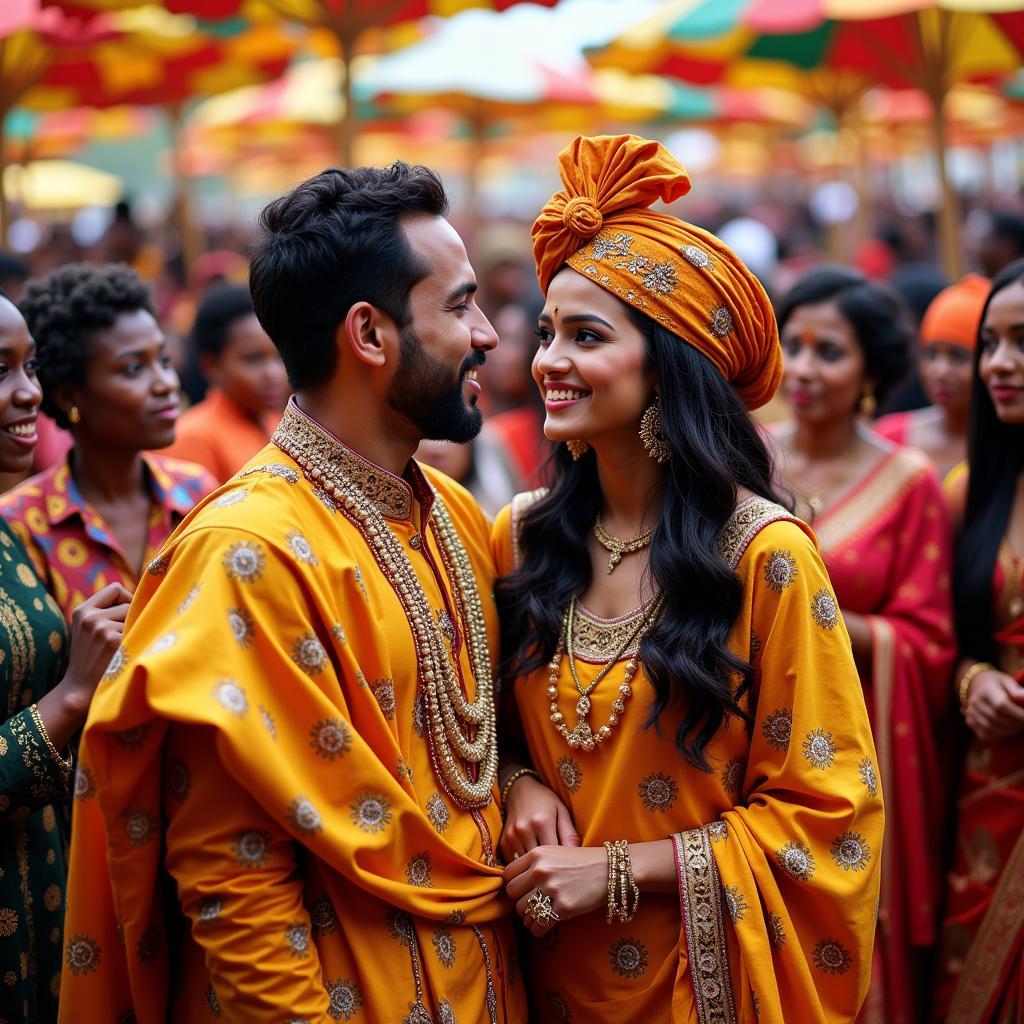Discovering the Magic of African Indigo Dyeing
African Indigo Dyeing is a vibrant tradition woven deeply into the cultural tapestry of numerous African communities. For centuries, the distinctive blue hues of indigo have adorned textiles, clothing, and objects, representing not just aesthetic beauty but also social status, spirituality, and cultural identity. This article delves into the rich history, intricate processes, and enduring significance of African indigo dyeing.
From the arid landscapes of the Sahara to the lush rainforests of West Africa, indigo dyeing has taken root in diverse environments, each region evolving its unique techniques and artistic expressions. The process, while varying in specifics, generally involves fermenting indigo leaves to extract the dye, then dipping fabrics into the resulting solution to imbue them with the characteristic blue color. Learn more about vibrant African fabrics online.
The History and Cultural Significance of Indigo in Africa
Indigo’s journey through Africa is a fascinating tale of cultural exchange and innovation. Evidence suggests that indigo dyeing was practiced in West Africa as early as the 11th century, predating its widespread use in Europe. The dye quickly became a symbol of prestige and power, often reserved for royalty and religious leaders. In some cultures, indigo-dyed cloth played a vital role in ceremonies and rituals, symbolizing purity and connection to the spiritual world. You can find beautiful African fashion blouses showcasing this rich dyeing tradition.
Variations in Techniques Across the Continent
The methods of African indigo dyeing vary significantly across the continent, reflecting the ingenuity and adaptability of different communities. In some regions, such as Mali, the dyeing process is a communal activity, often involving women who share knowledge and skills passed down through generations. Other areas, like Nigeria, have developed specialized indigo dyeing pits, carefully maintained and used for generations.
The Science Behind the Blue: Understanding Indigo Dyeing
The magic of indigo dyeing lies in the chemical transformation of the indigo plant. The leaves contain indican, a colorless compound that, when fermented, converts to indigotin, the blue pigment responsible for the vibrant color. This process requires careful control of oxygen levels and pH balance, showcasing the scientific understanding embedded within this ancient art. Check out a wide variety of African fabric designs that utilize indigo.
From Plant to Pigment: The Indigo Dyeing Process
The process begins with harvesting and drying indigo leaves. These leaves are then soaked and fermented in a carefully prepared solution, often using alkaline substances like potash or lye. This fermentation process releases the indigotin, which is then oxidized by exposure to air, transforming the solution from a yellowish-green to the deep blue characteristic of indigo dye. Fabrics are then repeatedly dipped into the dye bath, allowing the color to deepen with each immersion. African beard dye also utilizes natural ingredients, though with different processes.
Modern Applications and the Future of African Indigo Dyeing
While rooted in tradition, African indigo dyeing continues to evolve and adapt to the modern world. Contemporary artists and designers are incorporating indigo-dyed fabrics into their creations, bringing this ancient art form to new audiences. There is also a growing movement to promote sustainable and ethical indigo production, ensuring the long-term viability of this cherished tradition. You can find African fabric by the yard for your own indigo dyeing projects.
Preserving a Legacy: Supporting Sustainable Indigo Dyeing
By supporting ethical producers and learning about the rich history of African indigo dyeing, we can contribute to the preservation of this cultural treasure. This ensures that future generations can continue to appreciate the beauty and significance of this ancient art form.
Conclusion
African indigo dyeing is more than just a craft; it is a living testament to the creativity, ingenuity, and cultural richness of Africa. From its ancient origins to its modern interpretations, indigo dyeing continues to captivate and inspire. By understanding and appreciating the history and techniques behind this art form, we can help ensure its continued vibrancy for generations to come.
FAQ
- What is African indigo dyeing? A traditional dyeing method using the indigo plant to create rich blue hues.
- How is indigo dye made? By fermenting indigo leaves and oxidizing the resulting solution.
- Why is indigo important in African culture? It symbolizes status, spirituality, and cultural identity.
- Are there different types of indigo dyeing in Africa? Yes, techniques vary across different regions.
- Is African indigo dyeing sustainable? Efforts are being made to promote sustainable production practices.
- Where can I learn more about African indigo dyeing? Museums, cultural centers, and online resources offer valuable information.
- Can I buy authentic African indigo textiles? Yes, from reputable artisans and fair trade organizations.
Are there other questions you have in mind? Explore more about African textiles and fashion on our website. For assistance, please contact us at +255768904061, kaka.mag@gmail.com, or visit us at Mbarali DC Mawindi, Kangaga, Tanzania. Our customer service team is available 24/7.


